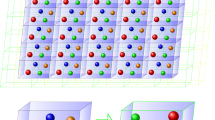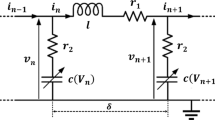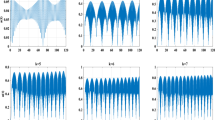Summary
The rise process, steady-state and decay process of the birefringence of poly-γ-benzyl-l-glutamate solutions under the action of a rectangular pulse have been studied at 25 °C over a wide range of field strength of 1.5×103 to 3×104V/cm. The solvent used was a dichloroethane-dimethylformamide mixture of the volume ratio 99∶1. From the decay process the average relaxation time extrapolated to zero concentration and the corresponding rotational diffusion constant were determined. The apparent dipole moment and the optical anisotropy factor were obtained from the field strength dependence of steady-state birefringence. The rise process was analyzed according to our theory which holds for arbitrary high field strength in the initial stage. The Δn(t)/t versus t curves for various field strengths were found to be linear in the initial stage and pass through the origin. Thus, it was concluded that the electrical orientation of poly-γ-benzyl-l-glutamate in solution is due primarily to the permanent dipole moment. Furthermore, the value of the apparent permanent dipole moment obtained from the rise process was compared with that obtained from the steadystate birefringence.
Zusammenfassung
Der Einschaltvorgang, der stationäre Zustand und das Abklingen der Doppelbrechung bei Poly-γ-benzyl-l-glutamat-Lösungen mit einem elektrischen Impuls von rechteckiger Form werden bei 25 °C über einem großen Feldstärkebereich von 1.5×103–3×104V/cm untersucht. Als Lösungsmittel wird die Dichloräthan/Dimethylformamid-Mischung im Volumenverhältnis 99∶1 verwendet. Aus dem Abklingvorgang werden die zur Konzentration 0 extrapolierte mittlere Relaxationszeit und die entsprechende Rotationsdiffusionskonstante bestimmt. Das scheinbare permanente Dipolmoment und der optische Anisotropiefaktor werden aus der Feldstärkeabhängigkeit der stationären Doppelbrechung ermittelt. Der Einschaltvorgang wird nach unserer Theorie, die für beliebige hohe Feldstärken im Anfangsverlauf gültig ist, analysiert. Die Δn(t)/t gegen t-Kurven für verschiedene Feldstärken sind geradlinig im Anfangsverlauf und laufen durch den Ursprung. Hieraus zeigt sich, daß die elektrische Orientierung von Poly-γ-benzyl-l-glutamat in Lösungen hauptsächlich durch das permanente Dipolmoment bedingt ist. Überdies wird der aus dem Einschaltvorgang gewonnene Wert des scheinbaren permanenten Dipolmomentes mit dem aus der stationären Doppelbrechung ermittelten Wert verglichen.
Similar content being viewed by others
References
For a review, seeK. Yoshioka, H. Watanabe, in: Physical Principles and Techniques of Protein Chemistry, Part A,S. J. Leach, Ed. p. 335 (New York, N. Y. 1969).
Benoit, H., Ann. Phys.6, 561 (1951).
Tinoco, I., Jr., J. Amer. Chem. Soc.77, 4486 (1955).
O'Konski, C. T., K. Yoshioka, W. H. Orttung, J. Phys. Chem.63, 1558 (1959).
Schwarz, G., Z. Physik145, 563 (1956).
Nishinari, K., K. Yoshioka, Kolloid-Z. u. Z. Polymere235, 1189 (1969).
Matsumoto, M., H. Watanabe, K. Yoshioka, J. Phys. Chem.74, 2182 (1970)
Doty, P., J. H. Bradbury, A. M. Holtzer, J. Amer. Chem. Soc.78, 947 (1956).
Tinoco, I., Jr., J. Amer. Chem. Soc.79, 4336 (1957).
Boeckel, G., J.-C. Genzling, G. Weill, H. Benoit, J. Chim. Phys.59, 999 (1962).
Tsvetkov, V. N., Yu. V. Mitin, V. R. Glushenkova, A. E. Grishchenko, N. N. Boitsova, S. Ya. Lubina, Vysokomolekul. Soedin.5, 453 (1963).
Tsvetkov, V. N., I. N. Shtennikova, E. I. Ryumtsev, V. S. Skazka, Vysokomolekul. Soedin.7, 1111 (1965).
Tseetkov, V. N., I. N. Shtennikova, E. I. Ryumtsev, G. F. Pirogova, Vysokomolekul. Soedin.9A, 1575, 1583 (1967).
Tsvetkov, V. N., I. N. Shtennikova, V. S. Skazka, E. I. Ryumtsev, J. Polymer Sci. C16, 3205 (1968).
Yamaoka, K., Ph. D. Thesis, University of California (Berkeley, 1964).
Watanabe, H., Nippon Kagaku Zasshi85, 403, 468, 603 (1964);86, 179 (1965).
Watanabe, H., K. Yoshioka, A. Wada, Biopolymers2, 91 (1964).
Watanabe, H., K. Yoshioka, Biopolymers4, 43 (1966).
Matsumoto, M., H. Watanabe, K. Yoshioka, Biopolymers6, 929 (1968).
Marchal, E., C. Hornick, H. Benoit, J. Chim. Phys.64, 514 (1967).
Powers, J. C., Jr., J. Amer. Chem. Soc.88, 3679 (1966);89, 1780 (1967).
Powers, J. C., Jr., W. L. Peticolas, in: Ordered Fluids and Liquid Crystals, p. 217 (Washington, D. C. 1967).
Powers, J. C., Jr., W. L. Peticolas, Biopolymers9, 195 (1970).
Mukohata, Y., S. Ikeda, T. Isemura, J. Mol. Biol.5, 570 (1962).
Mukohata, Y., J. Mol. Biol.7, 442 (1963).
Spach, G., Compt. Rend.249, 667 (1959).
Tinoco, I., Jr., J. Amer. Chem. Soc.79, 4248 (1957);81, 1540 (1959).
Wallach, M. L., H. Benoit, J. Polymer Sci.57, 41 (1962).
Jennings, B. R., H. G. Jerrard, J. Phys. Chem.69, 2817 (1965).
Blout, E. R., R. H. Karlson, J. Amer. Chem. Soc.78, 941 (1956).
Ikeda, K., H. Watanabe, M. Shirai, K. Yoshioka, Sci. Pap. Coll. Gen. Educ., Univ. Tokyo15, 139 (1965).
Yoshioka, K., H. Watanabe, Nippon Kagaku Zasshi84, 626 (1963).
Broersma, S., J. Chem. Phys.32, 1626 (1960).
Luzzati, V., M. Cesari, G. Spach, F. Masson, J. M. Vincent, J. Mol. Biol.3, 566 (1961).
De Loźe, C., P. Saludjian, A. J. Kovacs, Biopolymers2, 43 (1964).
Yang, J. T., P. Doty, cited in ref. J. Amer. Chem. Soc.79, 4336 (1957).
Wada, A., J. Chem. Phys.30, 328, 329 (1959); Bull. Chem. Soc. Japan33, 822 (1960).
Matsumoto, M., H. Watanabe, K. Yoshioka, to be published.
Matsumoto, M., H. Watanabe, K. Yoshioka, Biopolymers9, in press (1970).
Author information
Authors and Affiliations
Additional information
With 7 figures
Rights and permissions
About this article
Cite this article
Nishinari, K., Yoshioka, K. The rise process of the electric birefringence of poly-γ-benzyl-l-glutamate at high fields. Kolloid-Z.u.Z.Polymere 240, 831–836 (1970). https://doi.org/10.1007/BF02160081
Received:
Issue Date:
DOI: https://doi.org/10.1007/BF02160081




